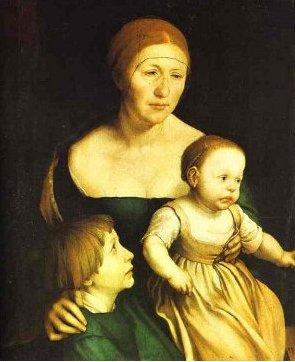Who is it who said that “the image kills the imagination”? The word “image” here designates the result of a mechanical process, reducing to objective data what is subjective, unique, and living in a being or a landscape. Is it an accident that the lens of a camera is called the “objective”? Indeed, an image may be a work of art, but most of those which bombard us daily life lack this quality. If we allow ourselves to be subjected to this diet of images without a critical eye, we sink into passivity and lose – little by little – our imagination. Imagination: it is the aptitude, the ability that can raise us, in our daily life, to the rank of the inspired artist who, in a painting or a picture, presents us with a being to contemplate, a being whose real presence we keenly feel. Below is a painting by Hans Holbein which arouses compassion. Of this painting, Wendell Berry would say: If you had met this woman and her children, you would have needed, to be touched by them, an act of imagination analogous to the act of the artist. The other only exists for us as and when we recreate that other. Philosopher Simone Weil conceived of the world as analogous to a work of art. Wendell Berry thinks about compassion in the same way.
 |
| Hans Holbein, Charity or The Family of the Artist, 1528 |
Sometimes, in a public place such as a subway car or bus, we stare at a stranger, who slowly becomes a real presence to us. This is our imagination at work. It slams up against a wall, however, the wall of our ignorance. We know nothing of this stranger’s past; thus our surge of compassion stops midway. Such experiences help us understand why belonging to a community is so important. It is only in and through a shared life that the compassionate artist we each are can find the ingredients – in this case the memories – which will allow us to re-create the presence of the other.
Here is the page Wendell Berry has dedicated to the art of compassion:
''Too much disclosure of the intimate, the secret, the sexual, the private, and the obscene is accomplished by mentioning or representing or picturing but not imagining. To represent the intimacy of desire or of grief without the art that compels one to imagine these things as the events of lives and of shared lives is actually to misrepresent them. This is the “objectivity” of the schools and the professions, which allow a university or a corporation to look at the community—its own community—as one looks at a distant landscape through fog. This sort of objectivity functions in art much the same as in science; it obstructs compassion; it obscures the particularity of creatures and places. In both, it is a failure of imagination.
Journalism and the electronic media, for example, routinely exhibit representations or disclosures of intimate emotion as objects of curiosity, as intrinsically interesting, or as proofs of artistic or journalistic courage. The perennial act of cutting-edge enterprise in reporting is to shove a camera or a microphone into the face of a grieving woman. But what is the qualitative difference between the man who cold-heartedly shoots another and the photographer who cold-heartedly photographs the corpse or the grieving widow? Are they not simply two parts of the same epidemic failure of imagination, which is to say a failure of compassion and of community life?
Such exposures do not make us free, and they do not increase our knowledge. They only compound human cruelty by a self induced numbness to the suffering of others and to our common suffering.
To be indifferent to hurts given by one’s writing to its human subjects, which exactly parallels the scientific-industrial indifference to the suffering of animal or human subjects of exploitation or experimentation—to say “I don’t care, I don’t give a damn”—is a betrayal not only of the subject of writing, which is invariably our common life, our neighbourhood , but also of imagination itself. It is a refusal to be compassionate, a denial of the vital link between imagination and compassion. How can such a betrayal not impair one’s ability to know the truth and to make art?
The world and its neighborhoods, natural and human, are not passively the subjects of art, any more than they are passively the subjects of science-industry-and-technology. They are affected by ail that we do. And they respond. The world does not exist merely to be written about, any more than it exists merely to be studied. »
Life is a Miracle, Counterpoint, Washington, D.C. p.86.


 The editor of L'Encyclopédie de L'Agora and well known newspaper chronicler and philosopher, analyses actuality through the looking glass of Belonging.
The editor of L'Encyclopédie de L'Agora and well known newspaper chronicler and philosopher, analyses actuality through the looking glass of Belonging.